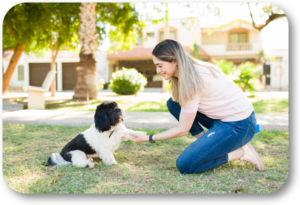Robin and I were in Woodstock last Tuesday having lunch at Rootstock’s. It was a perfect day and we decided to eat outside in the fresh air. We had just come from a dog training session, so we had pulled up with our “Dog Training” magnets on our car and we were wearing our “North Georgia Dog Training” polo shirts. Just as we were finishing lunch, the person having lunch at the table next to us turned around and asked, “Are you the dog trainers?”

“Well, yes; we are”, we replied, “Can we help you?”. Our “lunch neighbor” went on to explain that she had recently rescued an eight-month-old Weimaraner and was trying to train him. Although she had trained dogs before, Frida, her Weimaraner, just wasn’t “getting it”. She was working with her every day on a whole bunch of commands. Sometimes Frida would do the right thing and sometimes she would just stare into the distance. Did we know what was going on with her training and Frida?
Before we started to give any advice, Robin and I needed to get a little more information about “Frida’s educational process”. We discovered that Frida was a rescue and had already traveled between several families before she reached her current home. Our lunch neighbor’s family was made up of her, her husband, and three very active boys; all under the age of twelve. Needless to say, things were a little hectic.
We also learned that she was trying to train Frida multiple commands at once. She didn’t have any particular order to the command progression and wasn’t aware that Frida would need to know some commands before others. She also used several, divergent techniques, when training. With all this, we had enough information to offer some “sage advice”.
Very similar to us, dogs need to learn at a specific speed and at a particular level. Different than us, their learning process doesn’t allow them to “jump around” or “skip chapters in the textbook”. A successful canine learning process is characterized by being slow, methodical, repetitive, and consistent.
When your dog “isn’t getting it”, it normally means that you are trying to teach him a command that is just too complicated for him at the moment. If you think this is happening, you must back up to find a place where your dog can succeed in the exercise and then slowly proceed from that point. For you and your dog, there is no shame in going back a few grades to find a place where he can learn and you can teach.
Let’s work through an example:
Let’s say you are working with your dog on the “Come” exercise. You had him in the house and you were using a 6 foot leash to have him move from where he was to your side. Every so often you had to give a slight tug on the leash to get his attention and to guide him to you. All in all it was working pretty well.
Things seemed to be going really well so you took your dog to the back yard without the leash and moved to the far side of the yard from him. You gave the “come” command and he didn’t come. You tried this over and over again, day after day with the same results.
It isn’t that your dog is stupid or ignoring you. He still is a smart dog. You just tried to move too quickly and jump ahead too fast. Think back when you were in school and you just learned addition. The next day the teacher handed out calculus textbooks and said “Now, turn to page twelve and let’s do the problems”. Your teacher would obviously be trying to push you too fast.
I suggest that you go back into the house and review the level of knowledge that you knew your dog understood. (“Come” from 6 feet using the leash.) Next, I would suggest you get a longer leash and practice the come command from ten feet in the house. When that seemed great, practice from fifteen feet and then twenty feet. After that, and only after that; I suggest that you take your dog outside. But when you do, keep the leash on him and repeat the process you just successfully completed in the house.
Keep it slow, simple, and repetitive and you will get great results. Remember, this is not only about the “Come Command”. It is about anything you will be teaching your dog. Once you have the tools to be a great teacher, you will be able to teach your dog anything.
Please call Robin or me at (770) 718-7704 if you need any dog training help. We are blessed to have been your local dog training professionals for over seventeen years. We have trained over 5,000 great dogs and loving families and are ready to help you.

Follow Us!